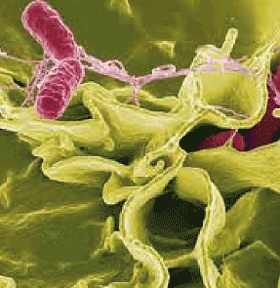



Reducing Food-borne Illness: Gut Health
Genes and genetic pathways involved in the intestinal health of chickens and pigs are described and genome-wide prediction tools for intestinal health are defined in the final scientific report from the EU group, Sustainable Animal Breeding (SABRE) subtitled 'Cutting Edge Genomics for Sustainable Animal Breeding'.The aim of this work was to provide the knowledge necessary to reduce the risk of food-borne infections, by delivering more sustainable breeding strategies for safe, high quality food and sustainable food production. Genes and genetic pathways involved in the intestinal health of chickens and pigs were identified, and genome-wide prediction tools for intestinal health were defined
Why Improve Intestinal Health?
The gastrointestinal tract is the major site where food meets the animal’s body, and is converted into metabolites that fuel cells. The food is also scrutinized for the presence of toxic or pathogenic components by the immune system of the intestine. The gastrointestinal tract is the primary site for the intake, processing, conversion, and absorption of nutrients and the barrier for pathogens. Improving the management of animal gut health is crucial to reducing the risk of foodborne infections, reducing the use of antibiotics and feed additives. Intestinal tissues may directly be damaged and exposed to pathogens, resulting in disease and the risk of increased susceptibilities to other infectious diseases.
The existence of genetic differences in susceptibility to intestinal infections has been demonstrated in several animal species. The basis for these differences was unknown at the beginning of the project. Dissection of this disease susceptibility and related traits such as nutrient uptake were therefore required as well as identification of genes and molecular pathways that govern gut health.

Research for Improved Gut Health
Salmonella is a type of bacteria. It is usually found in poultry, eggs, unprocessed milk and in meat and water. Food-borne infections affect all age groups and both sexes. Children, the elderly and people who are already ill are much more likely to get a serious infection.
The presence and control of Salmonella infections in chicken flocks remain important public health issues. The European Community has now forced poultry producers to minimize Salmonella contamination in breeders and layers (Zoonosis Directive EC/92/117). In addition, the prophylactic use of antimicrobials in poultry production was banned in 2006 by the European Commission, except under very limited circumstances, such as on animal health and welfare grounds, in order to minimise the development of antibiotic resistance. These challenges will all have an impact on poultry health. Two different aspects of gut health were investigated in this project: (1) susceptibility to infectious diseases and (2) nutrient uptake. The major focus was to increase our understanding of gut health and to identify important genes that govern gut health.
Innate Immune System
The innate immune system is the first line in defence from infection by other organisms. This means that the cells of the innate system recognise and respond to pathogens in a more generic way and less specific when compared to the protective response. It is now obvious that innate immunity both provides an important initial response to pathogens that can limit or even prevent infection, and crucially determines the course of an adaptive immune response, and hence the ability to respond to future infection with the same pathogen. This SABRE research identified genes and molecules of the innate immune system, which play an important role in maintaining a healthy gut.
Genes for Intestinal Functions
This SABRE research identified genes and molecular pathways involved in the immune response to various organisms to ensure a healthy gut. Our improved knowledge can now be used for managing intestinal health, either by breeding or using nutritional approaches. Specific knowledge was obtained on salmonella susceptibility in chickens and pigs, Eimeria susceptibility in chickens, Campylobacter susceptibility in chickens, E. coli susceptibility in pigs and Ascaris suum and Trichuris susceptibility in pigs.
Feed Efficiency
Feed efficiency in pigs and chickens was also studied to investigate nutrient uptake. We identified gene differences affecting feed efficiency which will impact on future breeding strategies.
Further Reading
| - | You can view the previous article from the SABRE report by clicking here. |
January 2012








